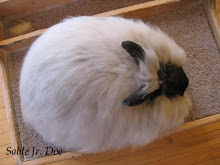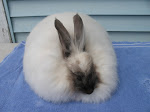This week on vacation I managed to get 3 does bred and and am shooting for two more tomorrow, and I got some juniors clipped down in prep. for the upcoming spring show season.
An unbelievable miracle occurred today. It was 60F (!!!!). Without wasting a moment, I grabbed my grooming table and blower, planted them outside, and thoroughly blasted each of my potential entries for the PA show in Feb:). After this I clipped down 3 more babies, bred 1 doe, and will continue clipping and breeding until everything is finished and I have nothing to concentrate on but new babies in the nestbox:).
One of my newer bucks, Henryi, is going to be siring 2 of the new litters. Angelo, a Chestnut buck, will sire one and possibly 2 if I decide to use him with Yvonne, and I will probably use Giacomo with Natalya as soon as I can get them both sheared. Next spring I will focus on using Giacomo and Fabrice almost exclusively while Henryi and Angelo are in coat, and some of the up and coming bucks will join the roster as well (later in the season).
I am also in the process of revamping my website this winter (actually I had planned on getting that done earlier too, LOL), and then I will be adding lots of new pictures and loading a bunch of articles to make the whole thing more complete.
More again in a couple of days as life gets settled again, but I'll leave you with a parting shot of Giacomo after his wild session with the blower:-). He is super disheveled because of the fierce wind that was blowing here all morning (in addition to the one I created, LOL) and he is also looking rough because his coat is pretty well shot at this point, having gone past prime and down the road to slippage :^).




























